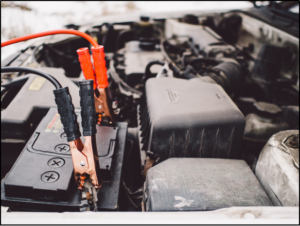
Learning how to jump start a car with the use of jumper cables, or a portable battery jump starter is an essential skill for anybody who knows how to drive. No wait, it’s a rite of passage, especially if you’re a man. Why? That’s a good question. Where do I start? What if someone you know asks for your help to get their car started? What if that someone is your best mate? Or your dad? Or some person stuck in a snow storm? Or it’s that hot new intern you’ve been trying to get a date with? Or the simple fact that if you own a car, sooner or later, you will leave the engine on all night, and find a dead battery the next day. Point is, knowing how to jump start a car is an important skill for any man. Now, that we’ve got your priorities straight, let’s get back to business.
This is going to be a guide for drivers, so that they can invest in the right equipment to jump start their car, and will never get caught off guard while on the road.
How to Jump a Car?
Unless you just happen to be the luckiest dude there is, you will at some point in time find that you turn the ignition key of your car only to be greeted by…nothing, or in other words, a flat battery! For a person who drives their car to and from work, nothing can mess up your day more than the distressing clicking sound that is one of the first red flags of a car that has a flat battery. This is the reason why some folks keep a set of jumper cables or a portable battery jumper in the trunk of their vehicle. You’d think that a tool that important to getting your day back on track will be used by all drivers, but surprisingly, that’s not the case, since many people are still not that clued up to what battery jumpers even do.
Starting the Car — with Jumper Cables
First of all, you need to make sure whether the jumper cables you’re using are in good working condition. This means checking to see if the insulation has not been damaged, leaving the conductive wire inside exposed to the elements. Apart from that, you also need to make sure the wire is connected to the jaws securely. Before you can use the jumper cables to get your car started, you are going to need a second car which has got a battery that’s working. This could mean you will need someone else’s assistance while you jump your car, preferably that someone will have the car with the working battery. Now,
- Park the second car or the one that’s functioning in a position which will allow both the batteries to be as close as possible.
- Before you go any further, make sure both the cars have been switched off and in neutral and engage the parking brakes.
- Then, when you have made sure that both the cars are switched off and in neutral, connect the red jaw clamp of the jumper cable to the positive (+) terminal of your flat battery, and then the other end to the positive terminal of the working battery. In this way, you will prevent a short circuit. Most cars use the body as a conductor for the negative pole, which basically means that your entire vehicle is negatively charged. So, touching the body of the car with a positively charged jumper cable will obviously cause a short circuit, and that’s something you do not want.
- Now, do the same for the black jaw clamps of the jumper cable and connect to the negative (-) terminal on the battery. It’s easier to connect the negative jaw to the unpainted surface of the body of the car that has the flat battery.
- Remember to never allow the insulation on the jumper cables to touch a hot engine.
- Then, once you have successfully connected the jumper cables start the second car (that’s functioning). Press down gently on the accelerator to allow the revs to climb to around 1500 or 2000 RPM. Now, hold the revs at that point for a few seconds, and then release the accelerator allowing the car to idle normally.
- You can then start the car with the flat battery while the jumpers are still connected to the battery. If the first try fails, try again after a few minutes.
- Eventually, the car should start. Once the car starts, don’t switch the engine off since it needs to run to recharge the battery. This usually means keeping the engine running for around at least 15 minutes.
- Finally, you can remove the jumper cables from both the batteries while avoiding any contact between the two jaws and between the positive jaw and the body of either vehicle. And voila!
Starting a Car — with a Portable Jumper
Those of you who prefer a portable jumper, you will have to adhere to the same safety precautions as with the jumper cables. Using a portable jumper is often times the preferred option for car owners since it is safe and easier. The best part being you will not require a second car with a working battery to jump your flat battery since the portable jumper has its own portable battery. This also significantly decreases the risk of a short circuit of any of the cables coming in contact with each other. But, that being said, there are still some things to keep an eye on when using a portable jumper to jump start your car battery. The following are a few tips to get it done the right way.
- Remember to have the portable jump starter switched off whenever you connect or disconnect it to the battery to keep it from short circuiting.
- Once the ignition of the car and battery jumper switched off, connect the positive (+) jaw of the battery jumper to the positive terminal of your car’s flat battery. Then, connect the negative (-) jaw of the battery jumper to the negative terminal of the battery or an unpainted surface of your car.
- While doing that, it is important to make sure that the insulation of the cables does not come in contact with the hot engine or it will melt the insulation and may also cause the car to short circuit.
- Now that you have connected the battery jumper properly, switch it on and start your car.
- If your car doesn’t start initially wait for about 15-seconds before trying again.
- Once you’ve got the car engine running again, switch the portable jump starter off and disconnect the jaws from the battery.
Performance Tool Jumper Cables
When it comes to jumper cables, Performance Tools has a wide range of cables to offer, which are sturdy built and intended to be affordable for the average driver. When looking for jumper cables, the first thing to keep in mind is its durability since they are going to remain in your car’s trunk. This means choosing those jumper cables with high quality jaw clamps that are robust and well built. Also, make sure the cable uses a decent grade of copper cable so it doesn’t malfunction after a few jumps.
Since you will not be using your jumper cable every day, the jumper cables from Performance Tool will be ideal for the average car owner. This is because spending money on heavy duty jumper cables when you will not be using it often is going to be a waste of money. When choosing a good quality jumper cable, the difference between the options will not be easily apparent. But, you can get a good idea of what you are buying by reading the reviews of these products.
Performance Tool — W1672
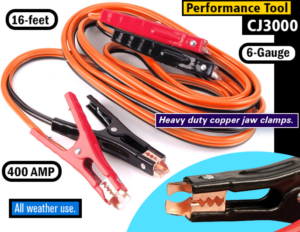
Features:
- Tangle-free rubber coated cables.
- Standard duty jumper cables ideal for large cars and SUVs and mid-size pick-up trucks.
- Red/black PVC-coated insulated clamps for easy identification.
- Heavy duty copper jaw clamps.
- All weather use.
- 6 Gauge, 16 Foot, 400 AMP/500 Peak
Overview
For beginners who don’t have experience in how to jump start a car, the Performance Tool – W1672 is ideal since it is considered as beginner jumper cables. With a 6-gauge copper wire, and an amp rating of 400A (500A peak), the Performance Tool – W1672 is perfect for jump starting medium to large sized cars, along with standard pickups or SUVs. While long jumper cables will give you more room to work with, a jumper cable of 16 feet is reasonable enough and will serve its purpose well.
The Performance Tool – W1672 is also an ideal option for those who are not looking forward to spending much money on their first set of jumper cables. Also, the copper jaw clamps of the Performance Tool – W1672 might not be the easiest to use as the flat edge doesn’t clamp around battery terminals as well as rounded clamps do, but that being said, this is considered a minor issue, and often times, comes down to personal preference. For starting the average car, pickup or SUV, the Performance Tool – W1672 gets the job done nicely.
Performance Tool — W1669

Features:
- 2 Gauge, 20 Foot, 600 AMP/800 Peak
- All weather use
- Ideal for tractors, semis, buses, RVs and other commercial heavy duty vehicles
- High tension parrot style clamps
- Red/black PVC-coated insulated clamps
- Tangle-free, rubber coated cables
Overview
The Performance Tool – W1669 jumper cable is at the opposite side of the spectrum when it comes to jumper cables. The Performance Tool – W1669 features a 2-gauge copper cable that’s as thick as it gets. The jaws are rated for 600A with an 800A peak, and the extra length you get from the 20 FT jumper cables makes it much easier to work with as compared to jumper cables that are shorter. The length of a jumper cable is quite important since jumper cables with this type of amp rating will generally be used for starting larger diesel engine vehicles.
Another benefit of the Performance Tool – W1669 is that this jumper cable set is a tangle free cable, which means that they are a lot less frustrating to work with as compared to normal jumper cables that get tangled up easily. The heavy-duty jaw clamps of the Performance Tool – W1669 are also more durable and practical in their design with rubber insulated grips that makes them less susceptible to short circuiting. Also, the rounded jaw grip is better at gripping with most car battery models.
The Performance Tool – W1669 is a great choice for drivers with large vehicles and will also be a better option for mid-sized car owners, especially during cold weather. However, the average car owner won’t really need the high amps that these jumper cables carry.
Performance Tool — W1673
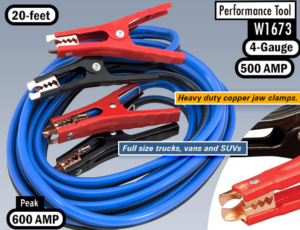
Features:
- Tangle-free rubber coated cables
- Red/black PVC-coated insulated clamps for easy identification
- Heavy duty for full size trucks, vans and SUVs
- Heavy duty copper jaw clamps
- All weather use
- 4 Gauge, 20 Foot, 500 AMP/600 Peak
Overview
Those car owners, who have large vehicles such as full-size pickups etc., will require the heavy-duty Performance Tool – W1673. This jumper cable has amperage of a whopping 500A and 600A peak, which is just the kind of power you need when your battery runs flat during those cold winter months. By using a 4-gauge, 20-FT cable you get just the right amount of load capacity needed, and the length is also better for reaching across a larger engine compartment found in SUVs, trucks or RVs.
The Performance Tool – W1673 features clamps that are similar to those on the thinner, 400A jumpers – so they are good, but not the best. These cables are also tangle-free, which is a nice addition. That being said, there’s really no such thing as a completely tangle-free cable, but this feature helps getting the jumper cables untangled when you need it.
Performance Tool — W1667
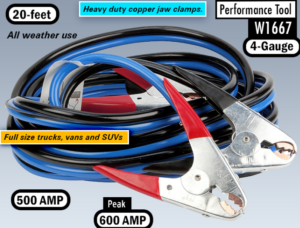
Features:
- 100% Copper Cable
- 4 Gauge, 20 Foot, 500 AMP/600 AMP Peak
- All weather use
- Heavy duty copper jaw clamps
- Heavy duty for full size trucks, vans and SUVs
- Red/black PVC-coated parrot clamps for easy identification
- Tangle-free rubber coated cables
Overview
The Performance Tool – W1667 is very similar to the previous jumper cables we’ve reviewed so far. The Performance Tool – W1667 also features a 4-gauge with a 10-foot jumper cable and 500A jaws, and a tangle-resistant cable design. This means the vehicle applications with the Performance Tool – W1667 are quite similar to the rest. But, the main difference with the Performance Tool – W1667 is the specially designed parrot-style clamps with rubber insulation for added protection. What sets these specific clamps from the rest is that they are far superior in build and design while still providing the same AMP rating so they are not expensive. Since the clamps are the first thing that drivers have problems with when it comes to jumper cables, it pays to invest in this option.
Performance Tool — W1671
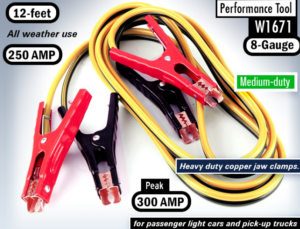
Features
- 8-Gauge, 12 Foot, 250 AMP/300 Peak
- Red/black PVC-coated insulated clamps for easy identification
- Medium duty for passenger light cars & pick-up trucks
- Heavy duty copper jaw clamps
- All weather use
- Tangle-free rubber coated cables
The Performance Tool – W1671 is the cheaper variety when it comes to jumper cables. The Performance Tool – W1671 features a sturdy 8-gauge (250A/300A) jumper cable. The jumper cable is of a convenient 12 feet, so it offers the driver with the leg room they need to jump their car. However, do not expect to jump start any vehicle with a large engine with the Performance Tool – W1671. The Performance Tool – W1671 is ideal for jumping passenger cars, or maybe a small pickup truck, but nothing larger. That being said, if you own a compact sedan then the Performance Tool – W1671 is going to be perfect for jumping the car whenever the battery goes flat.
Even the length of the jumper cables in the Performance Tool – W1671 is the ideal size to jump start a car’s battery by allowing the driver to have the room they need. While the Performance Tool – W1671 jumper cables aren’t as long as some of the other products mentioned here, it will however, long enough not to be the cause of a short circuit. When it comes to the cost of the Performance Tool -W1671, you’re not going to be paying much for this jumper cable. In fact, the affordable price is one of the main selling points of the Performance Tool – W1671.
Portable Battery Jump Starters
One common question that is asked by many car owners is what is a portable jump starter? The short answer is, these are the jumper cables that come along with a portable battery to jumpstart a car so that there’s no need to have another car with a working battery to jump your car whenever the batter goes flat. The portable jump starters are considered to be the most convenient way of jumping a car with a flat battery, especially during emergency situations, where there will be no other car in sight.
While all portable jump starters have pretty much the same functions, they differ in terms of battery power and other features of a portable jump starter. Since a portable jump starter has an internal battery, this variety of jump starters will also have other useful features such as lights, which can be used as a flashlight, or a warning light to warn other motorists when your car is parked at the side of the road. Many portable jump starters also feature a portable compressor to pump your tires if they run out of air, which is a nifty tool to have. Needless to say, you will have to pay more for the portable jump starter as compared to the regular jumper cables, but at the end of the day, the price is going to be worth it.
Schumacher XP2260
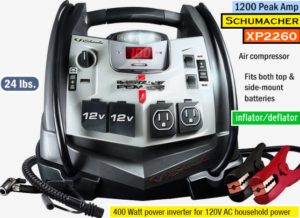
Features
- The cable will stay flexible in the coldest weather
- Swivel AC plug energy-efficient eco-charger for internal battery
- Sure-Grip clamps fit both top and side-mount batteries
- On/Off switch activates jump-starting mode
- Built-in charger
- Battery status LEDs indicate when battery is charged or needs to be charged
- Features a maintenance-free, sealed lead acid battery
Overview
Sporting the same name as the legendary F1 racer Michael Schumacher, the Schumacher XP2260offers the ultimate in performance and build quality. As the name implies, the Schumacher XP2260 does deliver more in both power and design when it comes to portable battery chargers. The first thing that will strike you about the Schumacher XP2260 is that it looks like something right out of a sci-fi movie. In fact, it wouldn’t be wrong to call the Schumacher XP2260 an all-in-one backup unit that takes care of all your automobile emergency needs.
The Schumacher XP2260 doesn’t just jump start the flat battery of your car, but can also inflate or deflate your car tires with its built-in 150psi air compressor. The Schumacher XP2260 features a 12v battery that has some incredible looking jaws that grab on to any battery firmly, regardless of whether the clamps are top or side mount. With a peak capacity of a whopping 1200A and a boost that can deliver a 185A punch in the starting, the Schumacher XP2260 looks like the best option for drivers who own large cars. That’s because it will be your best option. You can get a real-time read of the battery charge level via a digital display that’s large and easy to read. This is a valuable feature to have and takes away the guess work while charging your car.
The Schumacher XP2260 also features a build in 400V inverter with two 120V household outlets, a USB port and also a 12V charging port, so you can not only recharge the battery of your car, but other small appliances as well, such as your cell phone or laptop. The Schumacher XP2260 features a well-designed carrying handle that remains firmly gripped in your hand when travelling. With a weight of just around 23lbs, the Schumacher XP2260 is easy to carry and won’t take its toll on your back. And just in case all that wasn’t enough for you, the Schumacher XP2260 also comes along with a 1-year warranty.
NOCO Genius Boost Plus GB40
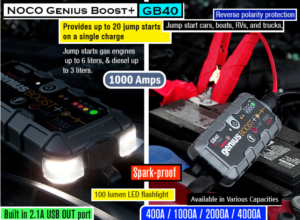
Features:
- A lithium battery jump starter rated at 1,000 Amps (7,000 Joules3S)
- 100 lumen LED flashlight with multiple modes, including SOS
- Jump starts gas engines up to 6 liters, and diesel up to 3 liters
- Provides up to 20 jump starts on a single charge
- Recharges USB devices, like smartphones, tablets, and more
- Spark-proof connections and reverse polarity protection
Overview
The NOCO Genius Boost Plus GB40 is another nifty portable battery jumper that’s superbly built and offers quite a few features, although does not have an inverter. But, that’s not a big deal since most jumpers don’t. The NOCO Genius Boost Plus GB40 features a boost charge of an impressive 1000A that’s more than enough to jump the flat battery of a car, semi-truck or RV. This is possible thanks to its 12v lithium-ion battery that’s inbuilt in this portable battery jump starter.
The NOCO Genius Boost Plus GB40 also features quite a few other features that make it a good investment such as the, bright LED flashlight (100 lumen) that also features an SOS function. The NOCO Genius Boost Plus GB40 also sports a 1.2A USB port for charging your cell phone, laptop or other similar devices. There’s also a 12V output and spark-free technology that does away with the danger of using a portable battery jump starter. This makes the NOCO Genius Boost Plus GB40 one of the easiest and safety battery jumpers available in the market today.
Ending Note
Having a dead or a flat battery is one of the most common problems faced by car owners. The worst part is that drivers are often times caught unaware and unprepared. This is where investing in a reliable battery jump starter is a smart choice when you want to get your vehicle running.


